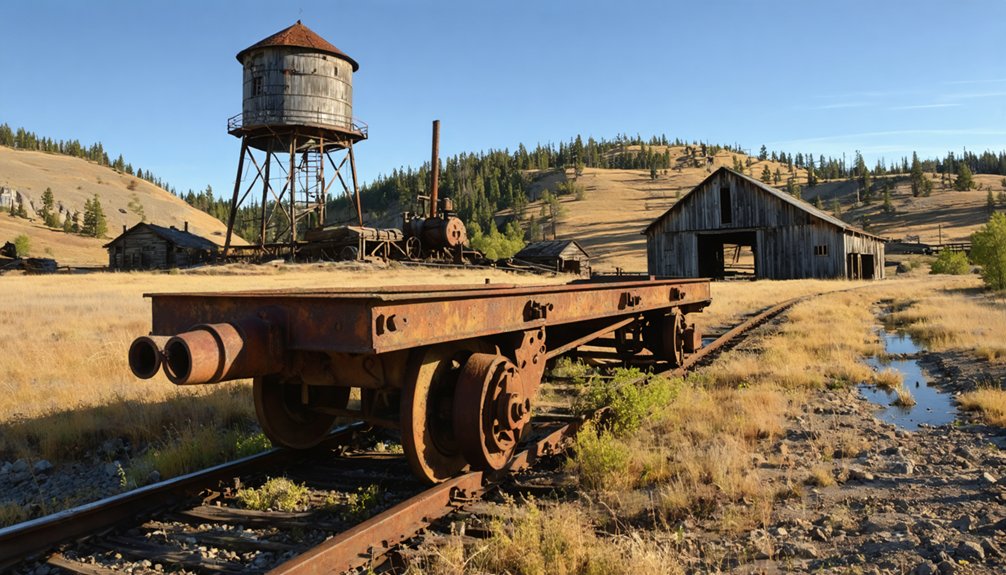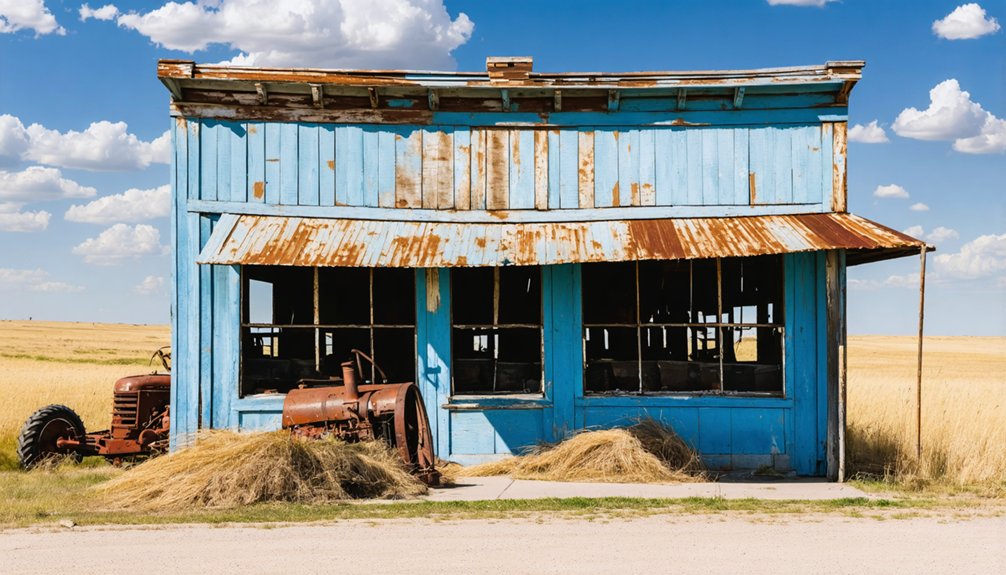You’ll find Mogul’s ghost town ruins in Lawrence County’s Ruby Basin Mining District of South Dakota’s Black Hills. This former sawmill and mining community thrived from 1907-1919, with the Mogul Mining Company leading technological innovations in cyanide processing of low-grade ores. Today, you can explore deteriorating structures, roofless buildings, and industrial remnants at elevations above 6,000 feet. The site’s atmospheric ruins tell a compelling story of boom-and-bust in early 1900s mining life.
Key Takeaways
- Mogul was an early 1900s mining town in South Dakota’s Ruby Basin Mining District, operating at 6,000 feet in the Black Hills.
- The Mogul Mining Company operated from 1907-1919, pioneering the cyanide process for extracting gold from low-grade ores.
- Twelve sawmills supported the town’s economy by 1900, alongside mining operations that employed hundreds of residents.
- Visitors can explore deteriorating structures, mine shafts, and industrial ruins, though caution is needed due to unstable conditions.
- The town’s decline began as mines faltered and was accelerated by the 1918-1919 influenza pandemic.
The Rise and Fall of a Sawmill Town
While many Black Hills settlements emerged from gold prospecting, Mogul developed primarily as a sawmill town supporting the region’s mining and settlement activities.
You’ll find its roots in the vast stands of yellow Ponderosa pine that drew enterprising sawmill operators to the area. The town’s sawmill operations quickly became its economic backbone, providing essential lumber for homes, businesses, and mine supports throughout the Black Hills.
At its peak, Mogul bustled with several hundred residents, and you could spot railroad lines crisscrossing the landscape for timber transportation. The twelve sawmills operating in the Custer area by 1900 reflected the region’s booming timber industry. Like many sites in various states, the town’s buildings and infrastructure gradually deteriorated after abandonment. The town thrived with general stores, lodging, and maintenance shops serving mill workers and their families.
However, as timber resources dwindled and larger, more efficient mills emerged elsewhere, Mogul’s prosperity faded. Without its sustaining industry, the town gradually emptied, leaving behind remnants of its lumber-focused past.
Life in the Black Hills Mining Community
Beyond Mogul’s lumber-focused economy, the broader Black Hills mining communities pulsed with the energy of gold seekers and their dreams of striking it rich.
You’d find diverse groups of miners working together, using evolving techniques from simple placer mining to complex hard-rock operations at places like the legendary Homestake mine. During the mining boom, heated gunfights over land claims erupted as prospectors fiercely defended their territories.
The community dynamics reflected the era’s spirit of opportunity and innovation:
- Miners adapted from basic hand-operated equipment to industrial-scale operations using chlorination plants and advanced extraction methods.
- Women emerged as vital community builders, maintaining social networks while supporting mining operations.
- Different ethnic groups formed unique cultural bonds, creating vibrant mining towns with their own traditions and social organizations.
Despite the challenges of low-grade ore and demanding work conditions, these communities thrived through technological advancement and collaborative spirit. The discovery of placer gold deposits in 1874 near present-day Custer sparked the initial wave of settlement that would transform the region.
Surviving Structures and Landmarks
Remnants of Mogul’s industrial past dot the landscape today, with deteriorating structures from the Mogul-Horseshoe Company forming the town’s most prominent landmarks.
You’ll find crumbling mine shafts, slag heaps, and industrial ruins that showcase the architectural decay of this once-bustling Black Hills community.
As you explore the site, you’ll discover foundations of lost buildings hidden beneath overgrowth, alongside roofless shells of homes and stores that tell stories of frontier life.
The town’s historical significance is most evident in its cemetery, where weathered headstones chronicle the lives of miners and their families.
Silent stone markers tell tales of those who carved their living from these Black Hills mines generations ago.
While nature reclaims much of Mogul’s territory, converted railroad grades now serve as hiking trails, letting you trace the footsteps of the town’s mining pioneers.
Like many South Dakota ghost towns, these abandoned structures create an ideal backdrop for aspiring photographers seeking unique historic visuals.
Just like over six hundred ghost towns exist in the Black Hills region, Mogul stands as another testament to the area’s rich mining heritage.
Railroad Legacy and Modern Trails
Although Mogul’s initial growth stemmed from mining operations, the town’s development became inextricably linked to the railroad expansion of the late 19th century. Named after the powerful 2-6-0 “Mogul” steam locomotive, the town thrived on railroad innovations that connected the Black Hills region’s mining communities. Once part of an extensive network serving regional mines, the area has seen over 50% decline in railroad infrastructure since its peak years. Many visitors may find certain interactive features unavailable if JavaScript is disabled while exploring the area’s virtual tour platforms.
You’ll find evidence of pioneering railroad engineering throughout the area:
- Narrow-to-standard gauge conversions using innovative third rail systems
- Strategic placement of trestles and bridges across challenging terrain
- Carefully graded rail beds that enabled efficient ore transport
Today, many of these historic rail corridors have found new life through trail conservation efforts.
While Mogul itself stands abandoned, the surrounding rail-trails preserve the region’s transportation legacy, offering you glimpses into the engineering feats that once connected this frontier town to the wider world.
Stories of Loss and Hardship
While the railroad brought initial prosperity to Mogul, the town’s story soon became one of profound hardship and loss.
You’ll find that when the mines began to falter, the community’s resilience was tested by a cascade of challenges. Workers and their families were forced to leave as job opportunities vanished, and essential services gradually disappeared. Younger generations’ lack of connection to local history made preserving memories difficult.
The emotional toll mounted as the 1918-1919 influenza pandemic struck the isolated town, claiming multiple lives.
Harsh winters, flooding, and limited medical resources only intensified the suffering. Those who remained faced increasing isolation as stores closed and younger generations moved away. Like many towns between Deadwood and Lead, Mogul struggled to maintain its identity as a mining community.
The rugged Black Hills landscape, once a source of mineral wealth, now complicated transportation and communication, further straining the dwindling population until Mogul could no longer sustain itself.
Exploring the Town’s Remnants Today
Today’s visitors to Mogul find a haunting scene of deterioration, where nature steadily reclaims what humans left behind. As an urban exploration destination, you’ll discover weathered wooden structures and stone foundations scattered across the landscape, telling silent stories of the town’s mining past.
Time weathers the bones of Mogul’s mining legacy, as abandoned buildings surrender to nature’s slow but relentless embrace.
When you venture into this South Dakota ghost town, you’ll encounter:
- Roofless buildings and partially collapsed walls, constructed from local wood and stone
- Original industrial remnants, including mining equipment mounts and weathered signage
- Overgrown pathways leading to building foundations and former town plots
You’re free to explore the site’s ruins, though you’ll need to watch your step – unstable structures and uneven ground create hazards throughout.
The surrounding badlands and hills frame these remnants, creating an atmospheric backdrop for photographers and history enthusiasts.
Mogul’s Place in South Dakota’s Mining Heritage

Nestled in Lawrence County’s Ruby Basin Mining District, Mogul established itself as a significant player in South Dakota’s mining heritage during the early 1900s.
Operating at elevations above 6,000 feet in the Black Hills region, Mogul Mining Company revolutionized mining techniques by implementing the innovative cyanide process, which allowed for efficient extraction of low-grade ores.
From 1907 to 1919, you’d have found the company pushing technological boundaries, especially after the 1912 fire that prompted the construction of a new, strategically located mill.
The economic impact of Mogul’s operations extended well beyond its immediate vicinity, ranking as one of the major producers in the Black Hills alongside the famous Homestake Mine.
Today, Mogul’s legacy lives on as a reflection of South Dakota’s rich mining history.
Frequently Asked Questions
Are There Any Documented Paranormal Activities or Ghost Sightings in Mogul?
Like shadows without substance, you won’t find documented ghostly encounters or local folklore from Mogul. Historical records and paranormal investigations haven’t revealed any verified supernatural activity in this forgotten South Dakota town.
What Wildlife Species Currently Inhabit the Abandoned Town Site?
You’ll find prairie dogs dominating the landscape, while coyotes and deer adapt to abandoned structures. Your wildlife observation might reveal eagles soaring overhead and various rodents claiming the town’s remains.
Has Anyone Attempted to Purchase and Restore Buildings in Mogul?
You’ll find no confirmed building restoration attempts, despite a $799,000 listing in 2011. A failed plan for historical preservation as a “living ghost town museum” marks the last known interest in Mogul.
Were Any Significant Artifacts or Treasures Discovered After the Town’s Abandonment?
Like footprints in shifting sand, you won’t find records of major artifact excavation or treasure hunting successes in this ghost town’s story. No significant discoveries have been documented since its abandonment.
Are There Restrictions or Permits Required to Visit Mogul?
You’ll find minimal visitation guidelines and access regulations, though it’s best to check with local authorities. You’re generally free to explore, but respect any private property boundaries you encounter.
References
- https://en.wikipedia.org/wiki/List_of_ghost_towns_in_South_Dakota
- https://westernmininghistory.com/towns/south-dakota/pluma/
- https://mad-peak.com/blog-posts-and-info/f/galena-south-dakota-adventure-into-a-wild-west-ghost-town
- https://www.youtube.com/watch?v=_0WNYsFLSLA
- https://www.sdpb.org/rural-life-and-history/2023-08-21/some-black-hills-ghost-towns-and-their-origins
- https://www.youtube.com/watch?v=Glucs_Rq8Xs
- https://www.blackhillsbadlands.com/blog/post/old-west-legends-mines-ghost-towns-route-reimagined/
- https://www.legendsofamerica.com/rochford-south-dakota/
- https://www.deadwood.com/history/history-timeline/
- https://www.sdpb.org/rural-life-and-history/A-Quick-History-of-the-Lumber-Industry-in-the-Black-Hills



